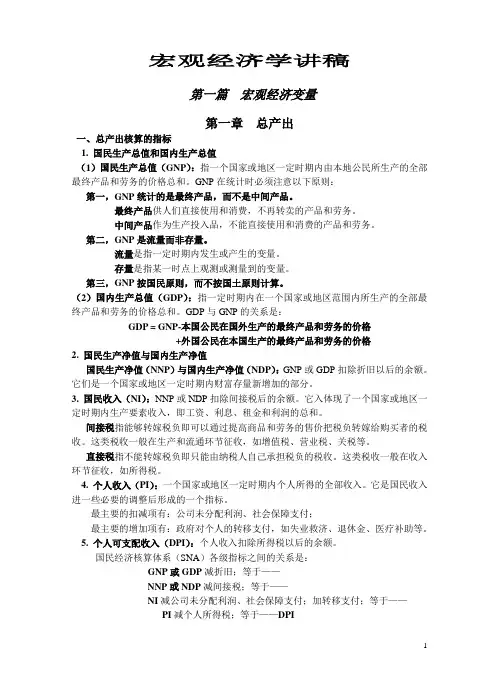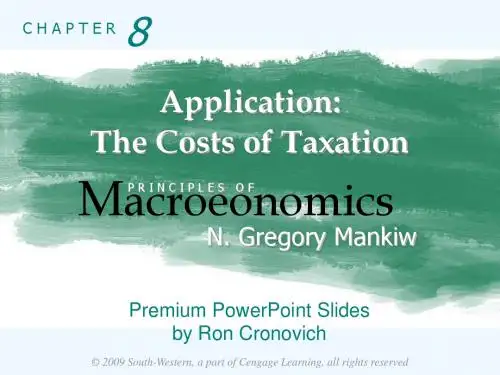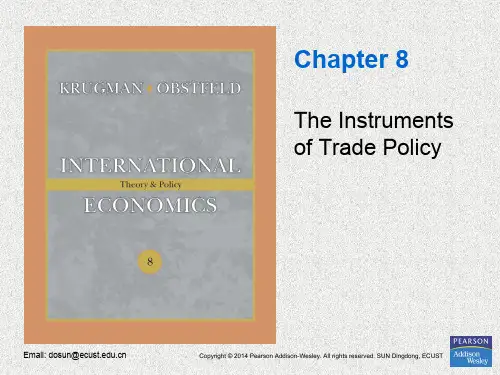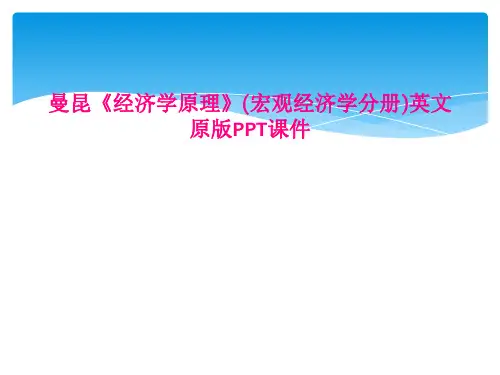曼昆《宏观经济学》(第五版)课堂讲义PPT(英文)Ch08
曼昆《经济学原理》(宏观经济学分册)英文原版PPT课件

© 2007 Thomson South-Western
Table 2 Real and Nominal GDP
© 2007 Thomson South-Western
Table 2 Real and Nominal GDP
© 2007 Thomson South-Western
Table 2 Real and Nominal GDP
© 2007 Thomson South-Western
THE ECONOMY’S INCOME AND EXPENDITURE
• When judging whether the economy is doing well or poorly, it is natural to look at the total income that everyone in the economy is earning.
Y = C + I + G + NX
© 2007 Thomson South-Western
THE COMPONENTS OF GDP
• Consumption (C):
• The spending by households on goods and services, with the exception of purchases of new housing.
© 2007 Thomson South-Western
THE MEASUREMENT OF GROSS DOMESTIC PRODUCT
• The equality of income and expenditure can be illustrated with the circular-flow diagram.
曼昆《宏观经济学》讲义.完整版

宏观经济学讲稿第一篇宏观经济变量第一章总产出一、总产出核算的指标1. 国民生产总值和国内生产总值(1)国民生产总值(GNP):指一个国家或地区一定时期内由本地公民所生产的全部最终产品和劳务的价格总和。
GNP在统计时必须注意以下原则:第一,GNP统计的是最终产品,而不是中间产品。
最终产品供人们直接使用和消费,不再转卖的产品和劳务。
中间产品作为生产投入品,不能直接使用和消费的产品和劳务。
第二,GNP是流量而非存量。
流量是指一定时期内发生或产生的变量。
存量是指某一时点上观测或测量到的变量。
第三,GNP按国民原则,而不按国土原则计算。
(2)国内生产总值(GDP):指一定时期内在一个国家或地区范围内所生产的全部最终产品和劳务的价格总和。
GDP与GNP的关系是:GDP = GNP-本国公民在国外生产的最终产品和劳务的价格+外国公民在本国生产的最终产品和劳务的价格2. 国民生产净值与国内生产净值国民生产净值(NNP)与国内生产净值(NDP):GNP或GDP扣除折旧以后的余额。
它们是一个国家或地区一定时期内财富存量新增加的部分。
3. 国民收入(NI):NNP或NDP扣除间接税后的余额。
它入体现了一个国家或地区一定时期内生产要素收入,即工资、利息、租金和利润的总和。
间接税指能够转嫁税负即可以通过提高商品和劳务的售价把税负转嫁给购买者的税收。
这类税收一般在生产和流通环节征收,如增值税、营业税、关税等。
直接税指不能转嫁税负即只能由纳税人自己承担税负的税收。
这类税收一般在收入环节征收,如所得税。
4. 个人收入(PI):一个国家或地区一定时期内个人所得的全部收入。
它是国民收入进一些必要的调整后形成的一个指标。
最主要的扣减项有:公司未分配利润、社会保障支付;最主要的增加项有:政府对个人的转移支付,如失业救济、退休金、医疗补助等。
5. 个人可支配收入(DPI):个人收入扣除所得税以后的余额。
国民经济核算体系(SNA)各级指标之间的关系是:GNP或GDP减折旧;等于——NNP或NDP减间接税;等于——NI减公司未分配利润、社会保障支付;加转移支付;等于——PI减个人所得税;等于——DPI二、总产出核算的方法1. 收入法:把一个国家或地区一定时期内所有个人和部门的收入进行汇总。
宏观经济学原理 第五版 英文原版课件macro-ch08-presentation

QE
Q
6
The Effects of a Tax
With the tax, CS = A PS = F Tax revenue =B+D Total surplus =A+B +D+F The tax reduces total surplus by C+E
APPLICATION: THE COSTS OF TAXATION
These effects are the same whether the tax is
imposed on buyers or sellers, so we do not make this distinction in this chapter.
APPLICATION: THE COSTS OF TAXATION
P
S
Size of tax
D
Q
15
APPLICATION: THE COSTS OF TAXATION
DWL and the Elasticity of Demand
P S
When demand is inelastic,
Size of tax
it’s harder for consumers to leave the market when the tax raises PB.
Would the DWL of a tax be larger if the tax were on:
A. Breakfast cereal or sunscreen? B. Hotel rooms in the short run or
hotel rooms in the long run?
C. Groceries or meals at fancy restaurants?
宏观经济学英文课件:ch08 The Instruments of Trade Policy

Copyright © 2014 Pearson Addison-Wesley. All rights reserved. SUN Dingdong, ECUST
8-13
The Effects of a Tariff (cont.)
Chapter 8
The Instruments of Trade Policy
Email: dosun@
Copyright © 2014 Pearson Addison-Wesley. All rights reserved. SUN Dingdong, ECUST
Preview
• The quantity of domestic import demand equals the quantity of foreign export supply when PT – P*T = t
• In this case, the increase in the price of the good in the domestic country is less than the amount of the tariff.
• Partial equilibrium analysis of tariffs: supply, demand, and trade in a single industry
• Costs and benefits of tariffs • Export subsidies • Import quotas • Voluntary export restraints • Local content requirements
曼昆微观经济学 第五版 第八章 课文PPT英文版

Consumer Surplus
Producer Surplus Tax Revenue Total Surplus
A+B+C
D+E+F none
A
F B+D A+B+D+F
- (B + C)
- (D + E) + (B + D) - (C + E )
Harcourt, Inc. items and derived items copyright © 2001 by Harcourt, Inc.
Price
When supply is relatively elastic, the deadweight loss of a tax is large.
Size of tax
Supply
Demand
0
Harcourt, Inc. items and derived items copyright © 2001 by Harcourt, Inc.
The Costs of Taxation
It does not matter whether a tax on a good is levied on buyers or sellers of the good…the price paid by buyers rises, and the price received by sellers falls.
How a Tax Affects Welfare...
Price Price buyers pay = PB Price without = P1 tax
曼昆《经济学原理》(宏观经济学分册)英文原版PPT课件

THE COMPONENTS OF GDP • GDP includes all items produced in the economy and sold legally n markets. • What Is Not Counted in GDP?
– Every transaction has a buyer and a seller. – Every dollar of spending by some buyer is a dollar of income for some seller.
© 2007 Thomson South-Western
Y = C + I + G + NX
© 2007 Thomson South-Western
THE COMPONENTS OF GDP • Consumption (C):
• The spending by households on goods and services, with the exception of purchases of new housing. • Investment (I):
© 2007 Thomson South-Western
Table 2 Real and Nominal GDP
© 2007 Thomson South-Western
Table 2 Real and Nominal GDP
© 2007 Thomson South-Western
Table 2 Real and Nominal GDP
• “. . . Final . . .” – It records only the value of final goods, not intermediate goods (the value is counted only once).
宏观经济学曼昆ppt课件
谢绝拷贝
宏观经济学
MACROECONOMICS
N.Gregory Mankiw (曼昆)
此幻灯片为纪念从教《西方经济学》二十周年
而作,并把她献给你们
我心中的太阳。
1
第1章 宏观经济学的科学
第一 节 宏观经济学家研究什么 Y = F(L,N,K,H)
总产出=总投入 总支出=总收入 总需求=总供给
6
4) GDP是计算期内生产的最终产品和劳务 的市场价值。 5) GDP 是一国范围内生产的最终产品和劳 务的市场价值。 6) GDP一般仅指市场活动导致的价值。
7
3.名义的GDP和实际的GDP
1) 名义的GDP(Nominal GDP) 以一定时期市场价格表示的国内生产总值, 称作该时期的名义的GDP。 2) 实际的GDP(Real GDP) 以某一年作为基年的价格表示的国内生产 总值,称作该时期的实际的GDP。
23
4. 漏出和注入
1)漏出指居民或企业的收入中作为储蓄、税 收和进口等而没有支付给对方的那部分。
2)注入指居民或企业得到的收入中,不是相 互由对方付给的那部分。如投资、出口、政 府支出等。
▪
W=J
▪ S + TA + IM + = I + G +EX +TR
24
5.漏出和注入的关系 漏出来之于注入,又归入于注入之中。 ▪ W > J,国民经济收缩。 ▪ W < J,国民经济扩张。 ▪ W = J,国民经济均衡。
D
QS= S(P,Pm)
0
Q
Q0 Q1
3
2. 模型的多样性
3. 价格: 伸缩性与粘性 市场出清 伸缩性
曼昆宏观经济学ppt课件(2024)
平台经济、共享经济等新模 式不断涌现,对传统经济理 论提出挑战。
2024/1/28
数据成为新的生产要素,对 经济增长贡献度不断提升。
需要加强数字经济理论研究 ,为政策制定提供科学依据 。
43
THANKS
感谢观看
2024/1/28
44
宏观经济学定义与研究对象
2024/1/28
宏观经济学定义
宏观经济学是研究整体经济现象 、经济运行规律及政府如何运用 经济政策调控经济的学科。
研究对象
宏观经济学以整个国民经济为研 究对象,包括总需求、总供给、 国民收入、就业、通货膨胀、经 济增长等问题。
4
宏观经济学与微观经济学关系
联系
宏观经济学与微观经济学都是经济学的重要分支,两者相互联系、相互补充。 微观经济学是宏观经济学的基础,宏观经济学则需要微观经济学的支持。
01
02
03
实际收入减少
物价上涨导致货币购买力 下降,实际收入减少。
2024/1/28
社会财富再分配
通货膨胀有利于债务人而 不利于债权人,导致社会 财富再分配。
经济秩序紊乱
通货膨胀可能导致价格信 号失真,经济秩序紊乱。
20
经济增长因素、模型及政策含义
劳动力投入
劳动力数量和质量的提高对经济增长有重要贡献。
04
实施积极的财政政策和货币政策,保持经 济稳定增长。
25
04
总供给与总需求模型分析
2024/1/28
26
总供给曲线形状及影响因素剖析
要点一
长期总供给曲线
要点二
短期总供给曲线
垂直,表示在长期内,经济总产出不受价格水平影响。
向右上方倾斜,表示短期内价格水平与总产出呈正相关。
曼昆经济学原理第五版宏观经济学优秀课件
的钱
钱的时间
这些钱的现值
$1
1年后
$1/(1.1) = $ 0.91
$1
2年后
$1/(1.1)2 = $ 0.83
$1
3年后
$1/(1.1)3 = $ 0.75
$30
3年后
$30/(1.1)3 = $22.54
这些AT&T公司股票的价值等于表中最后一列的数字相 加: $25.03
曼昆(经济学原理)第五版宏观经济学优秀课件
差别
▪ 例如:买$1000微软的股票,并持有30年
如果回报率 = 0.08, FV = $10,063 如果回报率 = 0.10, FV = $17,450
曼昆(经济学原理)第五版宏观经济学优秀课件
9
70规则
▪ 70规则:
如果一个变量每年按x%增长,那么大约在70/x年 以后,该变量翻一番
▪ 例如: ▪ 如果年利率是5%,那么大约在14年后存款额将
▪ 保险如何起作用:
面临风险的人向保险公司支付一笔保险费,作为 回报,保险公司同意接受所有或部分风险
▪ 保险允许风险分摊,能使风险厌恶的人更好:
比如,对于房子着火的风险,一万个人承担万分 之一的风险比你自己一个人独自承担全部风险容 易得多
曼昆(经济学原理)第五版宏观经济学优秀课件
14
保险市场的两个问题
B. 如果 r = 0.10,你是否应该买?
PV = $100,000/(1.1)5 = $62,090.
土地的PV <土地的价格
不, 不买它
曼昆(经济学原理)第五版宏观经济学优秀课件
8
复利
▪ 复利:货币量的积累,即赚得的利息仍留在账户
上以赚取未来更多的利息
曼昆的宏观经济学课件(英文版)
1990
1995
2000
2021/4/30
Why learn macroeconomics?
1. The macroeconomy affects society’s well-being. ▪ example: Unemployment and social problems
2021/4/30
Unemployment and social problems
• Why are there recessions? Can the government do anything to combat recessions? Should it??
2021/4/30
Important issues in macroeconomics
• What is the government budget deficit? How does it affect the economy?
▪ example 1:
Unemployment and earnings growth
▪ example 2:
Interest rates and mortgage payments
2021/4/30
%
Unemployment and earnings growth
5 4 3 2 1 0 -1 -2 -3 -4 -5 1965 1970 1975 1980 1985 1990 1995 2000
2021/4/30
Important issues in macroeconomics
• Why does the cost of living keep rising?
• Why are millions of people unemployed, even when the economy is booming?
- 1、下载文档前请自行甄别文档内容的完整性,平台不提供额外的编辑、内容补充、找答案等附加服务。
- 2、"仅部分预览"的文档,不可在线预览部分如存在完整性等问题,可反馈申请退款(可完整预览的文档不适用该条件!)。
- 3、如文档侵犯您的权益,请联系客服反馈,我们会尽快为您处理(人工客服工作时间:9:00-18:30)。
Chapter Eight
12
Efficiency of labor Labor-augmenting technological progress Endogenous growth theory
Chapter Eight
13
Chapter Eight
3
Technological progress causes E to grow at the rate g, and L grows at rate n so the number of effective workers L E is growing at rate n + g. Now, the change in the capital stock per worker is: Dk = i –(d+n +g)k, where i is equal to s f(k) sf(k) The Steady State
Chapter Eight 7
Chapter Eight
8
An important prediction of the neoclassical model is this: Among countries that have the same steady state, the convergence hypothesis should hold: poor countries should grow faster on average than rich countries.
Chapter Eight
9
?
The Endogenous Growth Theory rejects Solow’s basic assumption of exogenous technological change.
Chapter Eight 10
Start with a simple production function: Y = AK, where Y is output, K is the capital stock, and A is a constant measuring the amount of output produced for each unit of capital (noticing this production function does not have diminishing returns to capital). One extra unit of capital produces A extra units of output regardless of how much capital there is. This absence of diminishing returns to capital is the key difference between this endogenous growth model and the Solow model. Let’s describe capital accumulation with an equation similar to those we’ve been using: DK = sY - dK. This equation states that the change in the capital stock (DK) equals investment (sY) minus depreciation (dK). We combine this equation with the production function, do some rearranging, and we get: DY/Y = DK/K = sA - d
2
The Production Function is now written as: Y = F (K, L E) The term L E measures the number of effective workers. This takes into account the number of workers L and the efficiency of each worker E. Increases in E are like increases in L.
®
A PowerPointTutorial to Accompany macroeconomics, 5th ed. N. Gregory Mankiw
CHAPTER EIGHT Economic Growth II
Mannig J. Simidian
Chapter Eight 1
Chapter Eight
Chapter Eight
6
The introduction of technological progress also modifies the criterion for the Golden Rule. The Golden Rule level of capital is now defined as the steady state that maximizes consumption per effective worker. So, we can show that steady-state consumption per effective worker is: c*= f (k*) - (d + n + g) k* Steady-state consumption is maximized if MPK = d + n + g, rearranging, MPK - d = n + g. That is, at the Golden Rule level of capital, the net marginal product of capital, MPK - d, equals the rate of growth of total output, n + g. Because actual economies experience both population growth and technological progress, we must use this criterion to evaluate whether they have more or less capital than at the Golden Rule steady state.
(d + n + g)k
Note: k = K/LE and y=Y/(L E). So, y=f(k) is now different. Investment, Also, when the g term is added, sf(k) gk is needed to provided capital to new “effective workers” created by technological progress. Capital per worker, k
Chapter Eight 11
DY/Y = DK/K = sA - d This equation shows what determines the growth rate of output DY/Y. Notice that as long as sA > d, the economy’s income grows forever, even without the assumption of exogenous technological progress. In the Solow model, saving leads to growth temporarily, but diminishing returns to capital eventually force the economy to approach a steady state in which growth depends only on exogenous technological progress. By contrast, in this endogenous growth model, saving and investment can lead to persistent growth.
ChaБайду номын сангаасter Eight
5
Capital per effective worker is constant in the steady state. y = f(k) output per effective worker is also constant. But the efficiency of each actual worker is growing at rate g. So, output per worker, (Y/L = y E) also grows at rate g. Total output Y = y (E L) grows at rate n + g.
4
Chapter Eight
k*
Labor-augmenting technological progress at rate g affects the Solow growth model in much the same way as did population growth at rate n. Now that k is defined as the amount of capital per effective worker, increases in the number of effective workers because of technological progress tend to decrease k. In the steady state, investment sf(k) exactly offsets the reductions in k because of depreciation, population growth, and technological progress.
